Highlights of Some Recent COT Reports
A compilation of COT publications—regular reports, pamphlets, and letter reports—lists 723 documents ranging from a few pages to more than 1,000 pages in length. Some examples are described below. (See Appendix for list of selected COT reports.)
EXPOSURE LEVELS FOR CONTAMINANTS IN AIR
In the 1950s, COT received requests to recommend exposure limits (guidance levels) for airborne contaminants in military and spacecraft situations. These exposure limits are also useful to various agencies for responding to accidental spills or releases of hazardous materials affecting the general public. By late 1962, it was recognized that consistency in deriving these levels was impos-
|
Examples of COT Reports on Exposure Guidance Levels Guides for Short-Term Exposures of the Public to Air Pollutants (eight volumes, sponsored by EPA, published 1971-1973). Possible Long-Term Health Effects of Short-Term Exposure to Chemical Agents (three volumes, sponsored by the Department of the Army, published 1982-1985) Emergency and Continuous Exposure Guidance Levels for Selected Airborne Contaminants (eight volumes, sponsored by the Department of Defense, published 1984-1988). |
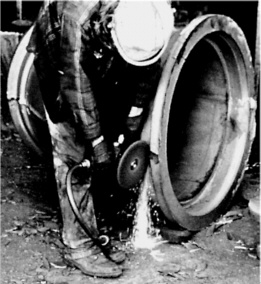
Hand-held disc grinder use, such as on this casting, can create particles of the bulk material being ground.
sible until basic principles were decided upon, and COT was asked to develop criteria for establishing emergency exposure levels. The report Basis for Establishing Emergency Inhalation Exposure Limits Applicable to Military and Space Chemicals was published in 1964.
COT has always emphasized that its emergency exposure guidance levels are to be used only in situations that occur unpredictably; they are not intended to be used in normal operations. Some exposures at the recommended levels might be objectionable to the senses and might cause temporary adverse effects, but they are judged not to incapacitate a person either mentally or physically with respect to performing an essential task, and exposed people are expected to return to normal without medical treatment. Emergency exposure levels are not derived by simple extrapolation of data from animals to humans. Rather, COT's decisions on each substance represent the consensus of the committee's experts after evaluation of known mechanisms of toxicity, experimental and clinical data, and operating conditions in which emergency exposures might occur.
COT has recommended emergency exposure guidance levels (EEGLs), short-term public emergency guidance levels (SPEGLs), and 90-day continuous exposure guidance levels (CEGLs) for hundreds of diverse chemical substances. COT's emergency exposure recommendations have been used by the Army, Navy, Air Force, and NASA as working standards in the absence of standards from OSHA. COT has also provided recommendations for exposure levels for the general public that have been used by EPA (fluorides, arsenic, and nitrates
and nitrites in drinking water), and the Air Force, Army, and NASA (rocket exhausts, smokes, and obscurants).
SUBMARINE HABITABILITY
One focus of COT's work for the Navy has been the recommendation of exposure limits (guidance levels) for atmospheric contaminants for crews working in the closed environment of nuclear submarines. There are many sources of air contaminants aboard submarines. Most sources release only small amounts of materials into the air, but there is always a potential for contaminants to build up during prolonged operation of a closed vessel. Therefore, since the 1960s, the Navy has been asking COT to provide emergency exposure guidance levels and continuous exposure guidance levels for contaminants found aboard submarines. Chemicals of interest to the Navy have included fuels, solvents, the chlorofluorocarbons used as refrigerants or to clean electronic and electrical equipment, pesticides, photographic developing chemicals, cigarette smoke, and even the fumes and combustion products of sound- and vibration-damping tiles used in submarines.
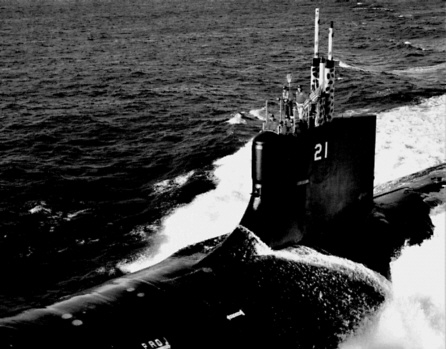
The Seawolf nuclear submarine.
In 1969, COT's recommendations were consolidated in a report on exposure limits for 14 air contaminants; for several years thereafter, the committee issued reports on the concentrations of those contaminants actually found in submarines. In 1985, COT began a comprehensive study on submarine air quality to develop emergency and continuous exposure guidance levels for potential contaminants in submarines, to evaluate the analytic techniques used in monitoring submarine contaminants, and to study the possible health effects in divers breathing compressed submarine air. In 1988, COT reported the results of this study in Submarine Air Quality: Monitoring the Air in Submarines and Health Effects in Divers of Breathing Submarine Air Under Hyperbaric Conditions. In the report, COT recommended exposure guidance levels for six substances of interest to the Navy: ammonia, hydrogen chloride, lithium bromide, toluene, trichloroethylene, and lithium chromate. COT found that cigarette smoke accounted for much of the particulate matter, carbon monoxide, and hydrocarbons in the submarine atmosphere. The committee recommended, and the Navy now supports, the elimination of cigarette smoking in submarines. COT also concluded that the toxicity of a substance increases in direct proportion to its partial pressure, and it concluded that it is reasonable for the Navy to set exposure levels for contaminants in divers' air by dividing current OSHA 8-hour permissible exposure limits by the pressure (in atmospheres) at which air will be breathed.
SPACECRAFT CONTAMINANTS
COT has assisted NASA manned-flight, space-shuttle, and space-station programs for many years. In 1971, NASA asked COT to review and make recommendations regarding the exposure levels for toxicants established in 1968 by the NRC Space Science Board. Evaluations of the exposure levels were important to NASA in connection with engineering benchmarks to guide the development of advanced life-support systems for long-term missions. In response, COT recommended provisional levels for 52 potential spacecraft contaminants for a variety of exposure durations (1 hour to 180 days). COT emphasized that the provisional levels represented maximum allowable concentrations of single contaminants and recommended an approach for dealing with complex mixtures of the contaminants.
In 1989, to ensure the health, safety, and functional abilities of astronauts, NASA requested COT's expertise in developing spacecraft maximum allowable concentrations (SMACs) for space-station contaminants. SMACs are used to provide guidance on allowable chemical exposures during normal operations and emergency situations. Several hundred chemical contaminants, most at very low concentrations, are likely to be found in the closed atmosphere of the space station. In 1992, COT published Guidelines for Developing Spacecraft Maximum Allowable Concentrations for Space Station Contaminants, which provides guidance for deriving SMACs and recommendations as to what types of data to
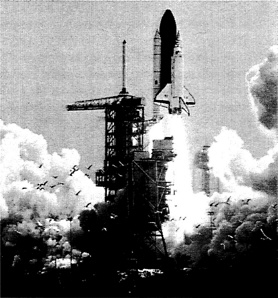
Space shuttle lifts off into space.
use, how to assess risk, and how to consider the effects of physiological changes induced by microgravity. Thus far, three volumes have been published in the series Spacecraft Maximum Allowable Concentrations for Selected Airborne Contaminants (Vol.1, in 1994 and Vols. 2 and 3, in 1996); these volumes contain exposure guidelines for 35 toxic substances likely to be encountered by astronauts in spacecraft.
ZINC CADMIUM SULFIDE DISPERSION TESTS
During the 1950s and 1960s, the US Army released particles of zinc cadmium sulfide (ZnCdS) from airplanes, rooftops, and moving vehicles in many urban and rural areas as part of a Cold War program to test how biologic weapons might disperse under various environmental conditions. Although ZnCdS is not a biologic weapon itself, it was chosen because it was thought to be nontoxic, its particles are similar in size to microorganisms used in biologic warfare, and its fluorescence under ultraviolet light makes it easy to trace. When these secret tests became public knowledge, residents in affected cities expressed concerns about possible health effects.
Pursuant to a congressional request, COT was charged in 1994 to review the available data on the Army's ZnCdS dispersion tests to determine the possible adverse health effects of human exposures. COT held public meetings in se-
lected cities where the ZnCdS tests had been conducted, and citizens were invited to voice their concerns and to present any relevant information. COT evaluated the available toxicity and exposure data on ZnCdS and its most toxic component, cadmium. COT concluded that even under highly conservative assumptions, the Army's tests did not expose residents of the United States and Canada to harmful chemical concentrations. The results of the evaluation, with recommendations for further studies, were published in Toxicologic Assessment of the Army's Zinc Cadmium Sulfide Dispersion Tests (1997). A nontechnical report was also prepared for the general public.
CHEMICAL-WARFARE AGENTS
Chemical-warfare (CW) agents used in military attacks are potential contaminants of air and field drinking-water supplies. No reliable acute-exposure standards have been established specifically for protecting soldiers from toxic exposures to CW agents. Some human-toxicity estimates are available for the most common CW agents—organophosphorus nerve agents and vesicants—but most of those estimates were developed for offensive purposes (that is, to assess the exposures that would kill or incapacitate the enemy) and were intended to be interim values only.
Because of the possibility of a chemical attack by a foreign power or terrorist, the Army's Office of the Surgeon General asked the Army's Chemical Defense Equipment Process Action Team (CDEPAT) to review the toxicity data on the nerve agents GA (tabun), GB (sarin), GD (soman), GF, and VX, and the vesicant agent HD (sulfur mustard), and to establish a set of exposure limits that would be useful in protecting soldiers from toxic exposures to those agents. In 1994, the Army prepared Review of Existing Toxicity Data and Human Estimates for Selected Chemical Agents and Recommended Human Toxicity Estimates Appropriate for Defending the Soldier. The report concluded that some previous human-toxicity estimates were too high and inappropriate for use in protecting soldiers. It proposed lower exposure levels. Before making a decision on acceptance of the human-toxicity estimates proposed by CDEPAT, the Army asked COT to review the Army report independently to determine the scientific validity of the proposed estimates.
COT's conclusions concerning the scientific validity of the Army's proposed estimates were grouped in four categories: (1) some estimates were judged to be scientifically valid, (2) some estimates were judged adequate to serve as interim estimates until further research is conducted, (3) some estimates need to be lowered, and (4) a few estimates could be raised. COT made recommendations for further research on the agents because in many cases, available data were insufficient or of poor quality.
In the report Guidelines for Chemical Warfare Agents in Military Field Drinking Water (1995), COT reviewed the toxicity of several CW agents, in-
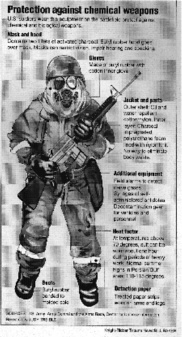
Protection against chemical weapons.
cluding organophosphorus nerve agents (GA, GB, GD, and VX), sulfur mustard agents (HD, THD, and HT), T-2 toxin, 3-quinuclidinyl benzilate, lewisite, and cyanide. This information was used to evaluate the Army's proposed field drinking-water standards. COT also made recommendations for preventing adverse health effects in military personnel exposed to CW agents in field drinking water and for improving the toxicity database on these agents. The Army has adopted the COT recommendations.
COT is currently involved in reviewing the Army's chronic reference doses for selected CW agents. The Army will use the reference doses to make decisions on cleanup of specific sites contaminated with CW agents. The results of this project are expected to be published in 1998.
PESTICIDES
Military personnel sometimes must be rapidly deployed to areas where insect-borne diseases are common, and they are thus placed at an increased risk of contracting such diseases as malaria, scrub typhus, leishmaniasis, and Lyme disease. The suddenness of deployments and movements after deployment often
precludes the use of ad hoc protection or control measures. To protect against disease risks from insect bites, the Army formulated a clothing impregnant containing permethrin—a pyrethroid insecticide—that is effective against disease vectors such as mosquitoes, ticks, and other arthropods. The Army proposed to use permethrin-impregnated fabric to manufacture battle-dress uniforms.
EPA has classified permethrin as a potential carcinogen, so there was concern that soldiers wearing permethrin-impregnated uniforms might face an unacceptable cancer risk. In response to that concern, the Army asked COT to review the toxicological and exposure data and make recommendations regarding long-term exposure to permethrin. COT conducted a detailed examination of the toxicity and pharmacokinetic data on permethrin in animals and humans and the potential exposures of military personnel and garment workers. In its report Health Effects of Permethrin-Impregnated Army Battle-Dress Uniforms (1994), COT concluded that permethrin-impregnated uniforms and material were unlikely to cause adverse health effects at the expected exposure levels.
In 1986, COT reviewed the Army's program to develop a replacement for N,N-diethyl-m-toluamide (DEET), the standard insect repellent used by the armed forces to combat diseases transmitted by insects. In the report Toxicity of Candidate Arthropod Repellents (1987), COT evaluated the Hazard Evaluation Program of the Armed Forces Pest Management Board treatment proposed by the Army and provided recommendations on how to improve the Army's toxicity-testing program for pesticides.
CONTAMINANTS IN DRINKING WATER
Since the 1960s, COT has performed a number of studies on toxic contaminants in drinking water. The committee has evaluated potable-water standards, determined the suitability of using certain materials as coatings in water tanks, evaluated the use of chemical sterilants for the interior surfaces of spacecraft potable-water systems, and determined the safety of certain chemicals used to purify drinking water. The committee has also been instrumental in ensuring the safety of public water supplies by reviewing EPA's drinking-water standards for contaminants.
Fluoridation of public drinking water has been a subject of controversy for decades. Despite evidence that fluoride reduces the incidence of tooth decay, some people believe that fluoridation of drinking water can cause dental fluorosis, skeletal fluorosis, cancer, soft-tissue effects, and arthritis. In response to the controversy, EPA requested an independent review of the toxicity and exposure data on fluoride and a characterization of the risks associated with ingesting fluoride. EPA also requested a determination of whether its regulatory maximum contaminant level (MCL) of 4 milligrams of fluoride per liter (4 mg/L) of drinking water was adequate for protecting public health. COT reviewed the
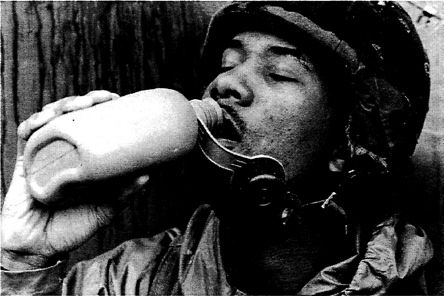
Safe drinking water is essential for both soldiers and civilians.
available toxicity data on fluoride and issued Health Effects of Ingested Fluoride (1993). It concluded that EPA's MCL for fluoride in drinking water was appropriate as an interim standard but recommended further research.
EPA also asked COT to evaluate the drinking-water MCL goals (MCLGs) and MCLs for nitrate and nitrite in public water supplies. In Nitrate and Nitrite in Drinking Water (1995), COT reviewed the basis of EPA's MCLGs and MCLs and the evidence that adverse health effects might result from total nitrate or nitrite exposure. Total human exposure to those substances and the contribution of drinking water to total exposure were assessed. COT concluded that the drinking-water MCLGs and MCLs for nitrate (44 mg/L) and nitrite (3.3 mg/L) provide adequate margins of safety for human health.
COT is currently reviewing EPA's drinking-water criteria for arsenic. The study includes evaluating the existing exposure and toxicity data on various inorganic and organic forms of arsenic in food and water. EPA is considering a more stringent standard for arsenic in water, possibly reducing the MCL from 50 mg/L (the interim MCL) to 2 mg/L. A change of such magnitude would have widespread effects on public water utilities and might increase compliance costs from $120 million to an estimated $5.4 billion per year. A report of COT's findings is expected to be published by the end of 1998.
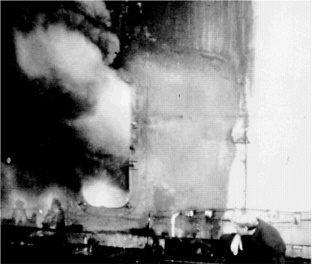
Toxicological exposure conditions involving a fire on board a ship.
DIOXINS
After a 1979 transformer fire in a NASA office building, the General Services Administration (GSA) and NASA asked COT to assess dioxin contamination of the building and to offer recommendations for remedial action. Dioxins are the most persistent pyrolysis products resulting from transformer fires. COT reviewed laboratory and epidemiologic data on several major dioxin isomers and related compounds, including their chemistry, toxic mechanisms, and health effects in animals and humans. It also reviewed four risk assessments that had been conducted to establish reentry standards for office buildings after transformer fires. COT recommended adopting the exposure guidelines first developed by the New York State Department of Health—concentrations of 10 picograms per cubic meter in the air and 25 nanograms per square meter on surfaces. The committee thereby gave GSA and NASA a basis for cleanup action to protect the health of workers. The 1988 report Acceptable Levels of Dioxin Contamination in an Office Building Following a Transformer Firealso provides other agencies and organizations with guidelines for similar cleanups.
MILITARY TOXICOLOGY-PROGRAM EVALUATIONS
COT has reviewed several of the military's toxicology programs. For example, in 1991, COT reviewed the Toxicology Division of the Army Environmental Hygiene Agency (AEHA). AEHA supports the Army's preventive-medi-
cine program, especially in occupational health and environmental toxicology. In Review of the U.S. Army Environmental Hygiene Agency Toxicology Division (1991), COT described a continuum of techniques (a series of activities that contribute to an overall health and safety program) used to prevent occupational and environmental diseases. The overarching goals of the continuum were priority setting and surveillance. COT recommended a number of ways to improve the toxicology program, particularly in determining which toxicological tests to perform and in choosing procedures for using toxicological data in assessments. AEHA and its Toxicology Division have implemented the recommendations of the COT report.
Recently, the Naval Medical Research and Development Command developed a program to support the health-related research needs of the Navy. Of particular concern were the amount and types of toxicological research conducted to support the Navy's operational requirements. COT issued Review of the U.S. Naval Medical Research Institute's Toxicology Program (1994). The committee recommended improvements in the toxicology program and its 10-year strategic plan. Most important, COT recommended the formation of a cost-effective triservice toxicology program that would eliminate unnecessary research and duplication of effort within the armed services.
At the request of the Navy, COT is currently conducting an independent review of the Navy's health-hazard evaluation process to determine whether it provides the Navy with state-of-the-art, comprehensive, and defensible evaluations of toxicity. A report is expected in 1999.
EMERGENCY RESPONSES
On rare occasions, COT provides emergency advice to DOD, usually because of a high national priority or a potentially life-threatening situation (see shaded box on the following page). Within days—sometimes within 24-72 hours—COT has provided interim answers concerning the type and degree of hazard being confronted, corrective measures, and other possible courses of action. Typically, the evaluations and recommendations in an interim letter report are then critically reviewed and evaluated by COT before a final report is forwarded to the sponsor.
In 1984, the Navy asked COT for an emergency response when contaminants were detected in the well water supplying its base on Diego Garcia, an island in the Indian Ocean. COT quickly determined that the insecticide dieldrin in the water was at higher than acceptable concentrations and recommended that the Navy seek alternative water sources. The Navy delivered drinking water to the base by air until other sources could be found.
One of COT's most notable emergency responses helped to avoid a US violation of the Intermediate Nuclear Forces Treaty with the Soviet Union. In 1988, the Army's planned destruction of the first intermediate-range missiles,
|
Selected Emergency Responses by COT Emergency Navy Request to Review the Drinking Water Standard for Dieldrin (March 1984) Emergency Army Request to Recommend Short-Term (Less than 30 Min) Exposure Criteria for Oxides of Nitrogen for Use in Limiting Exposures in Army's Armored Tanks (March 1985) Emergency Army Request for Evaluation of the Need for Setting Limits for Female Employees' Exposure to the Chemical Warfare Agent GB During Demilitarization of GB Weapons (March 1986) Emergency Army Request to Review Drinking Water Standards for Dibromochloropropane (July 1987) Emergency Army Request to Review the Appropriateness of the Army's Proposed Annual Time Weighted Average of 750 μg/m³ for HCL for the General Public and Appropriateness of Burning One Rocket Per Hour Up to A Maximum of Five Per Day (September 1988) Emergency Army Request to Review Drinking Water Standards for Diisopropyl Methyl Phosphonate (February 1990) Emergency Air Force Request to Review the Short-Term Public Guidance Levels (SPEGLs) for Monomethylhydrazine (November 1990) Emergency Navy Request to Review the Appropriateness of the Navy's Health Risk Assessment of Exposures to Pollutants Generated from Jinkinpo Incinerator in Atsugi, Japan (October 1995) |
required under the treaty, was prohibited by the state of Colorado because of fears of unacceptable public exposure to toxic vapors that might be released when the rocket motors were destroyed. COT was asked to review the problem on an emergency basis. The committee 's recalculations of the potential exposures provided a basis for the Colorado Department of Health to revise its decision, and Colorado allowed the Army to begin destroying missiles in time to avoid violation of the Intermediate Nuclear Forces Treaty.
In 1995, COT was asked to expedite a critical review of a report by the Navy's Environmental Health Center regarding health risks to Navy personnel and their families stationed near the Jinkinpo incineration complex in Atsugi, Japan. The incineration complex is a waste-combustion and disposal facility that was reported to emit many carcinogenic and noncarcinogenic pollutants. COT reviewed the air-sampling data from the naval air facility and concluded that the concentrations of volatile organic compounds and chromium in the air
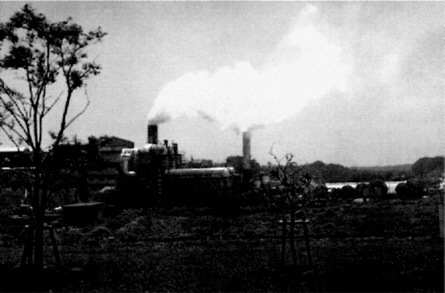
Jinkinpo incineration complex, Atsugi, Japan.
were potentially dangerous. The committee recommended that several interim measures proposed by the Navy be implemented to reduce the potential exposure of Navy personnel and their families to emissions from the incineration complex. The committee also recommended further studies to generate additional data for a more-comprehensive risk assessment. COT's report was used by the Navy to negotiate with the Japanese government on issues related to improving air quality, human health, and environmental conditions in the vicinity of Atsugi, Japan.
CURRENT PROJECTS
COT is currently addressing 10 projects for the Army, Navy, Air Force, NASA, and EPA (see shaded box on the following page). The projects address topics as varied as health risk assessments of exposures to CW agents, military smokes and obscurants, rocket emissions, synthetic fibers, spacecraft contaminants, drinking-water contaminants and reproductive and developmental toxicants. COT is also conducting a review of the Navy's health-hazard evaluation program for hazardous materials.
|
Current COT Projects (1997) Review of Reference Doses for Selected Chemical-Warfare Agents Identification of Reproductive and Developmental Toxicants Toxicologic Hazard Evaluation for Potentially Hazardous Materials Toxicity of Military Smokes and Obscurants Toxicity of Rocket Emissions Workshop on Toxicologic Risk Assessment: 50th Anniversary of the COT Review of EPA's Drinking Water Standard for Arsenic Review of the Navy's Permissible Exposure Limits for Man-Made Vitreous Fibers Spacecraft Maximum Allowable Concentrations (SMACs) for Space Station Airborne and Waterborne Contaminants Guidelines for Developing Spacecraft Maximum Allowable Concentrations (SMACs) for Space Station Contaminants in Drinking Water |














